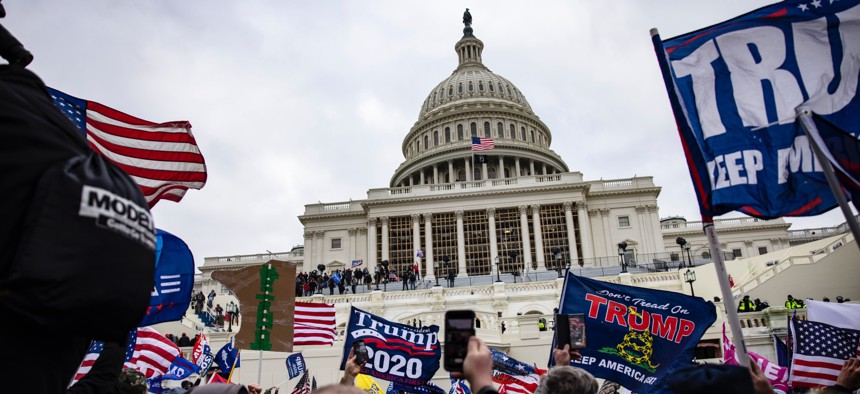Key federal agencies mostly followed procedure on Jan. 6, IG finds
The National Park Service could have taken more steps to prevent risks, auditor says, though organizer's lies made the planning more challenging.
The Interior Department generally followed its obligations in granting a permit to demonstrators near the White House and policing the riot that followed on Jan. 6, 2021, according to a new audit, though it failed to follow some of its own policies in overseeing the events.
The National Park Service, and its U.S. Park Police law enforcement component, had their jobs made more difficult after the organizers of the protest at the Ellipse—the Women for America First—intentionally lied to the agency about its intentions. The group repeatedly told NPS it would not march from the White House to the U.S. Capitol Building, though Interior’s inspector general found those were knowingly deceitful comments.
WFAF began its request for a permit on Dec. 19, 2020, the IG said, and NPS officials mostly followed proper procedure in granting it. They remained unbiased, engaged in ongoing conversations to solicit information about the event and properly assessed the potential risks, the auditors found.
The government maintains little discretion to reject permit applications, the IG noted, particularly in the National Capital Region. Acceptable reasons to deny a permit include another event scheduled at the same time, if the demonstration presents a “clear and present danger” or if the event will damage the park. While USPP and other law enforcement agencies shared some information prior to the event noting potential risks from the Jan. 6 events, the IG found NPS did not have sufficient evidence to reject the permit application.
On Dec. 21, USPP, recognizing the potential dangers, canceled all time off for employees scheduled for Jan. 6. It began issuing intelligence reports on the risks of the upcoming demonstrations. NPS held phone calls with WFAF organizers, who repeatedly said they had no plans to move off the Ellipse or march anywhere. NPS noted only federal personnel were permitted to be armed in the area. Just days before the event, WFAF increased its estimate for the event from 5,000 to 30,000 and notified NPS that President Trump was going to speak.
The IG faulted NPS for failing to secure a complete safety plan from WFAF. The group sent over some documents, such as an equipment list, timeline and trash plan, but not the required safety plan. Additionally, NPS failed to inspect the site of the demonstration, provide notice and postings about prohibited items and maintain photographs of the space beforehand to better document damage. The IG found NPS had time to demand and review a full safety plan, as well as to visit the planned site, but did not do so.
NPS later estimated the Ellipse suffered more than $200,000 in damages, but it did not seek to recover those costs from WFAF because it lacked evidence that its protest was the cause.
On Jan. 6, the IG said USPP carried out its duties properly. It arrested some individuals for assault, firearm possession and removing event barriers. In the latter instance, the arrest caused an outburst from onlookers and USPP personnel were forced to shelter in a Washington Monument security building with protesters pounding on the door until backup could arrive. Officers attempted to screen for explosives bags that demonstrators had abandoned on and around the National Mall after being told they could not bring them into the Ellipse, though they could not do so for each one.
NPS deployed officers to the Lincoln Memorial after Trump supporters with shields and gas masks swarmed the monument, but leadership instructed them not to resist making arrests if possible to avoid further agitation. The group eventually dispersed without incident.
USPP deployed around 200 officers to the Ellipse, most of whom stuck around at the mall out of fear more violence would erupt there. U.S. Capitol Police requested support just after Trump’s speech and USPP deployed 16 officers to the Capitol who fired pepper balls and other non-lethal weapons. Park Police offered to send an additional 40 officers, including a horse-mounted team, but Capitol Police never accepted the request.
In the buildup to the demonstration, USPP distributed an intelligence brief cautioning that “individuals may display more aggressive and desperate behavior” on Jan. 6 because they interpreted it as “their final opportunity to act on their grievances.”
The White House itself got involved in the planning of the event when the deputy chief of staff for operations asked Interior Secretary David Bernhardt and his deputy to intervene with an NPS decision to position the Ellipse stage off-center. At Bernhardt’s request, the stage was relocated so the White House would serve as its backdrop.
While WFAF repeatedly said the group would not march to the Capitol, the IG uncovered evidence the event organizers knew that claim was untrue.
“This stays only between us, we are having a second stage at the Supreme Court again after the ellipse. POTUS is going to have us march there/the Capitol,” one of the organizers said in a text on Jan. 4 to a potential speaker. “It can also not get out about the march because I will be in trouble with the national park service and all the agencies but POTUS is going to just call for it ‘unexpectedly[.]’”
The IG concluded WFAF “intentionally failed to disclose” that a march would take place.








